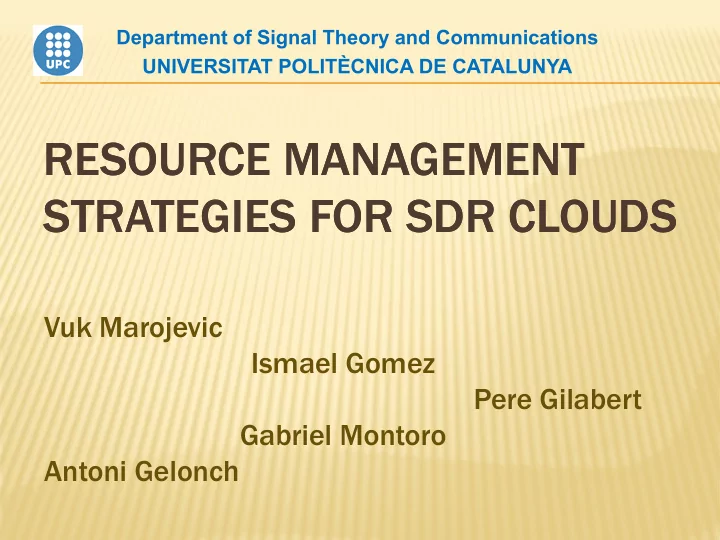

Department of Signal Theory and Communications UNIVERSITAT POLITÈCNICA DE CATALUNYA RESOURCE MANAGEMENT RESOURCE MANAGEMENT STRATEGIES FOR SDR CLOUDS STRATEGIES FOR SDR CLOUDS Vuk Marojevic Ismael Gomez Pere Gilabert Gabriel Montoro Antoni Gelonch
INDEX INDEX 1. Introduction 2. Resource Management Context & Approach 3. Resource Management Strategies 4. Simulations 5. Conclusions
INTRODUCTION INTRODUCTION
The Cloud Cloud computing is a model for enabling convenient, on-demand network access to a shared pool of configurable computing resources that can be rapidly provisioned and released with minimum management effort or service provider interruption. National Institute of Standards and Technology
Cloud Computing Architecture Application Layer Business , multimedia, web services Software framework: operating systems, Platform Layer application frameworks Infrastructure/ Virtualization VM storage Layer Memory Hardware Layer CPU (Data centers) Bandwidth Disk
Cloud Computing Characteristics Service oriented Multi-tenancy Ubiquitous network access Shared resource pooling Dynamic resource provisioning Self-organizing Utility-based pricing
The SDR Cloud Antenna Site Optical fiber AD AD CH-1 RF DA DA Data Center BS1 BS2 BS1 SWITCH Optical fiber network BS2
Advantages Radio infrastructure sharing (antennas, RF part) reduced deployment cost Computing resource sharing, fewer over-provisioning, secondary use of idle resources efficiency, scalability Waveform sharing, central repositories On-demand resource provisioning and charging New markets and market shares value-added services Data centers upgradable with latest technology
RESOURCE MANAGEMENT RESOURCE MANAGEMENT CONTEXT & APPROACH CONTEXT & APPROACH
Coverage Latency-constrained Transmission delay over optical fiber Distance, routing path, optical fiber switches 20 km data path: approx. 0.1 ms Assuming 10 km (6.2 mi) radius 314 km 2 (120 mi 2 ) (Barcelona: 100 km 2 , 1.6 M inhabitants)
Traffic Implications Independently session initiations and terminations Several communication sessions per day of different durations Users mobility More than 20,000 wireless communications sessions at peak (2 % of one million subscribers) 10 GOPS for the PHY processing per user 200,000 GOPS for 20,000 parallel sessions 10x, 100x, … for future SDR communications systems
Resource Management requirements Dynamic & continuous allocation and reallocation of resources Ensure real-time execution of waveforms under service- dependent throughput & latency constraints Adapt to the given traffic distribution Dispatch huge number of parallel session requests Acceptable session establishment times: real-time computing resource allocation Serve as many users a possible (high resource occupation)
Resource Management Waveform models f 1 f 4 f 2 f M … f 3 Mapping Data center model
Mapping Complexity • t w -mapping algorithm complexity: O ( M · N w +1 ) • Execution time in seconds (2.67 GHz i7 Quadcore, M = 24): w (window size) N (number of 1 2 3 processors) 20 0.005 0.09 1.57 30 0.025 0.61 16.23 40 0.075 2.43 87.77 50 0.17 7.2 326.4 100 2.9 221.3 - 200 68.6 - - 300 329.2 - - V. Marojevic, X. Revés , A. Gelonch, “A computing resource management framework for software- defined radios,” IEEE Trans. Comput. , vol. 57, no. 10, pp. 1399-1412, Oct. 2008.
Hierarchical Resource Management Waveform models f 1 f 4 f 2 f M … f 3 Data center model
High-level resource management Divide data center into computing clusters High-level resource manager assigns clusters to radio operators, radio cells, services, or … Dynamic clustering, slowly varying Account for communications statistics for secondary usage of idle clusters
Low-Level Resource Management Real-time allocation of computing resources (CPUs, memory, bandwidth, …) to waveforms Waveform modules then loaded to processors for immediately processing incoming/outgoing signals Very dynamic: resources allocated during session establishment and freed when session terminates
RESOURCE MANAGEMENT RESOURCE MANAGEMENT STRATEGIES STRATEGIES
Strategy 1 (S1): Operator Clusters Clusters assigned to radio operators Radio operators may demand a certain number of clusters based on expected traffic loads pre- allocations Dynamic allocation Combination resource pre-allocation (minimum resource guaranteed) and dynamic allocation Only few radio operators and large service area combining Strategy 1 with another
Strategy 2 (S2): Cell Clusters Clusters assigned to radio cells Different cell sizes & time-varying traffic loads Pre-allocations vs. dynamic clustering Clusters may grow or shrink as required S2 may simplify the access to the fiber optical network
Strategy 3 (S3): Service Clusters Clusters assigned to different services Service-dependent resource optimization goals Different services have more or less stringent timing and computing constraints High throughput services (mobile TV) allocate parallel resources Low latency services (voice, video) less parallelization, less processing latency S3 may be combined with another (S2)
SIMULATIONS SIMULATIONS
Simulation Setup 2 radio operators 64 radio cells 3G services: 64 kbps (voice), 128 kbps, 384 kbps, and 1024 kbps UMTS receiver digital signal processing chain (chip- & bit-rate processing model, ~7000-10,000 MOPS) Data center: 256 Quad-cores (1024 processors) 12 GOPS per core Fully connected
Scenarios 64 128 384 1024 User OP 1 OP 2 kbps kbps kbps kbps distr. voice data data data Uni- I 50 % 50 % 50 % 20 % 20 % 10 % form Uni- II 75 % 25 % 50 % 20 % 20 % 10 % form Uni- III 50 % 50 % 25 % 25 % 25 % 25 % form Gaus- IV 50 % 50 % 50 % 20 % 20 % 10 % sian
Scenario IV: Strategies • 64 radio cells, divided into 16 zones • 128 Quad-cores per operator assigned to zones as shown: Strategy 2.a Strategy 2.b 8 8 8 8 2 6 6 2 8 8 ·8 8 6 18 ·18 6 8 8 8 8 6 18 18 6 8 8 8 8 2 6 6 2
Scenario IV: Results
CONCLUSIONS CONCLUSIONS SDR clouds: merge SDR with cloud computing Scalable solution for wireless communications Computing resource management strategies Tradeoff between resource allocation efficiency and flexibility Results for different resource management strategies Dynamic adaptations needed Dynamically definable strategies
Recommend
More recommend